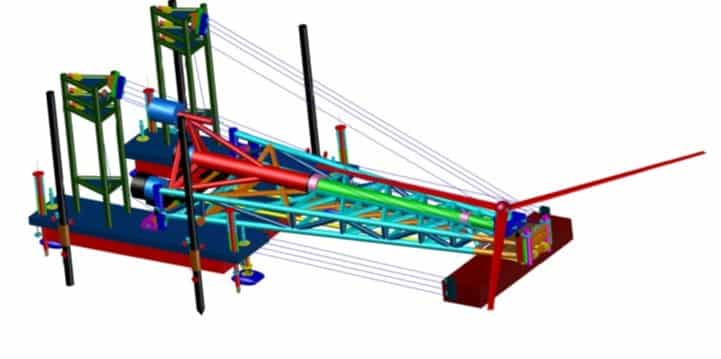
It is generally known that today’s wind turbines are giants, reaching up to 100 metres in height. But the latest models, which will be on the market within the next few years, will be even bigger – they will have a capacity of 12 to 15 megawatts, a hub height of 150 metres with blades of up to 105 metres long. Installing them in the sea on account of the strong winds is not possible in a safety-guaranteed manner with the current vessels and installation methods.
That’s why engineer Jan Lanser came up with the idea of developing a better method – the sit up system method, or SUS. In this method, wind turbines are assembled in the harbour, including the foundation that will be placed on the seafloor, which can then be transferred from the harbour to the sea in one day. This allows a wind park of 30 turbines, for example, to be placed at sea in one month, whereas it currently takes about four months to complete transport and installation.
How does the Marine Innovators method work?

“We are developing a vessel that horizontally ships the wind turbine assembled in the port, including the foundation, to the location at sea. The SUS vessel consists of a small pontoon at the front and a large submersible pontoon at the back which are connected to each other by means of a rotating framework. The wind turbine and the connected foundation are attached to the framework. After sinking and anchoring the large pontoon on the seabed, the framework and the windmill are rotated upwards by the upward force of the pontoon that is pulled under water. Once the wind turbine stands upright on the foundation, it is then placed vertically on the seabed in a controlled manner. By pumping water out of the suction anchors underneath the foundation, it can be anchored in the seabed at a low noise level, up to about ten metres deep.”
What was your motivation for developing this new installation system?
“In theory, our sit up system allows a wind turbine to be placed at sea within about 9 hours. Depending on the transport distance between the harbour and the wind farm of 50 km, the total transport and installation time takes between one and one and a half days. With the current method, this can take up to four or five days.
The short installation time of large wind turbines as well as the relatively low investment in a SUS vessel results in a relatively low cost price for the transport and installation of wind turbines at sea. The installation of wind turbines using a SUS vessel will be highly automated. As a result, the very large and heavy wind turbines can be installed with a minimum of manpower, but with a high safety level.
What is the biggest challenge for Marine Innovators?
“Ensuring that the design for the vessel with the sit up system is calculated statically and dynamically. It must then pass the model test in the Marin water management lab in Wageningen. This will show whether the calculations we have made using computer simulation techniques are consistent with the results of the test. In addition, we have to market the vessel. The construction of this type of vessel costs around 80 to 100 million euros. So we are looking for an investor, such as a company or a consortium of companies. Although the Netherlands is an offshore country, our national character lends itself less to the investment of venture capital in innovative concepts. In this respect, the US seems to offer a more suitable breeding ground.”
Which moment during the innovation process was the most rewarding for you?
“There were two moments. The first was in 2017, when we collaborated with Professor Andrei Metrikine of the Faculty of Civil Engineering & Geosciences at TU Delft, who brought in graduates who are involved in the development of the SUS concept. The second was in 2018, when the government invested more than 100,000 euros in the development of the SUS concept.”
What can we expect from Marine Innovators in the future?
“We want to launch the concept on the market within four years. Because the sit-up system method for placing wind turbines at sea costs ten times less than the existing installation methods, we are expecting a great deal of interest from both contractors, owners and operators of wind farms. Large CO2 consumers, such as Tata Steel in Beverwijk, also have an interest in CO2-free energy because in two years’ time they will have to pay high CO2 taxes. They therefore have an interest in installing a wind farm at sea to generate energy that they can use for their production processes.”
Founder: Jan Lanser
When: 2017
Where: Papendrecht
Turnover: approx. 50,000
Employees: 1 + partnerships with KCI Engineers and TU Delft
Ultimate goal: to bring a certified portfolio of technical drawings and calculations onto the market
Need more inspiration: Check all our Start-ups of the Day!

